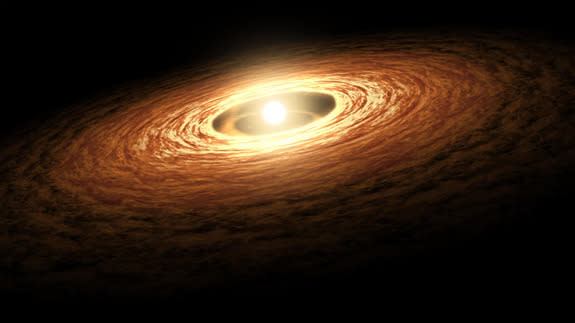Baby stars may grow in violent fits and starts

Young stars may grow through violent binges on raw cosmic material, a new study suggests.
Scientists used a high-powered telescope on Earth to take a look at four different young stars shining brightly and possibly going through some gravitational growing pains.
Those "outbursting" protostars may be one of the keys to understanding how stars evolve in the early stages of stellar life, the new study says. The research was published Friday in the journal Science Advances.
SEE ALSO: For the first time, scientists spot baby planets forming around an alien star
A team of researchers used the Subaru Telescope to investigate four young stars in infrared wavelengths of light, allowing them to see the structure of the material surrounding each star.
The new observations seem to suggest that the young stars may grow in fits and starts brought on by gravitational instability in the disk of material surrounding the star.
"The bursts of young stars requires sudden feedings with large amount of masses," said Hauyu Baobab Liu, a co-author of the study, in an email to Mashable. "We... believe that the most natural mechanism to explain such feeding, is gravitational instability."
Parts of the disk can become gravitationally unstable when a large amount of material collects in certain areas. Those clumps of matter — which can look like arms of the disk — then fall onto the star, causing bright outbursts and possible periods of extreme growth.
The new study comes to a different conclusion than some earlier studies looking at star formation. Previous research bolstered the idea that stars grow steadily, not in violent bursts as suggested by Liu.
Questions linger
Scientists still aren't sure how crucial these outbursting episodes are to the growth of the star system.
"This is an important phenomenon, since it's possible that stars, including perhaps our sun, gained most of their material in such phases," said astronomer Jonathan Tan, who wasn't involved with the study.

Image: National astronomical observatory of japan
"However, I would say this is still a matter of some debate about quantifying the importance of these bursting phases."
Earlier studies put forward the idea that the unusually bright appearance of these protostars may not be caused by extreme periods of growth, but instead are parts of the star's steady cycle of growth.
Theoretical modeling of star systems is also a very complicated business, Tan said, and this new study may have overlooked some important factors.
"Their work involves sophisticated simulations that follow the flows of gas and the effects of gravity," Tan said. "They also simulate how radiation will interact with the structures in their simulations. However, they do not appear to include the effects of magnetic fields, so there is more work to be done to be sure that this missing physics is not influencing the results of the simulations."
No matter the details, this new study could help scientists learn more about what our solar system may have experienced in the early stages of its development.
"Our approaches are based on the assumption that our solar system is not special. Neither is any other planetary system," Liu said.
"Following this logic, we believe that the detailed studies of the planetary system forming regions over a large range of evolutionary stages, can help understand the evolutionary history of our own solar system."

